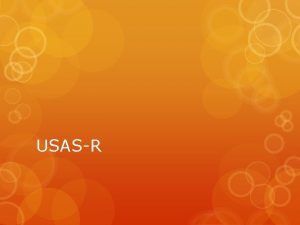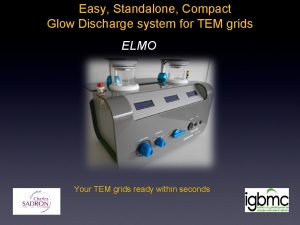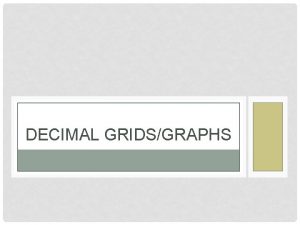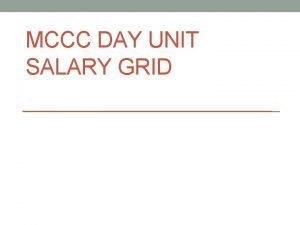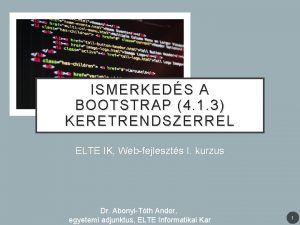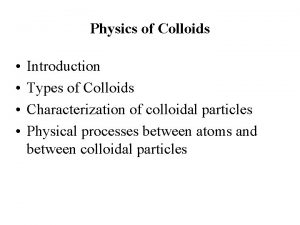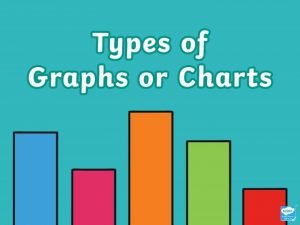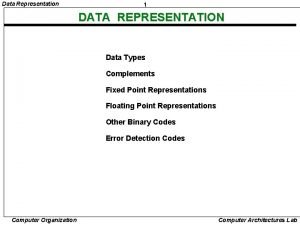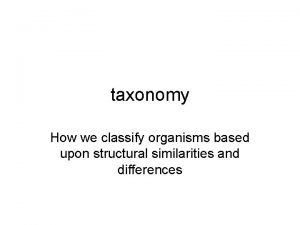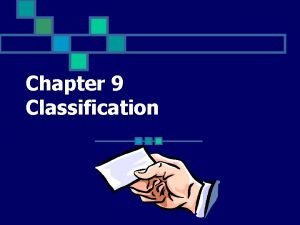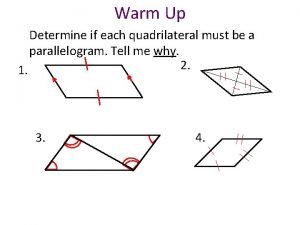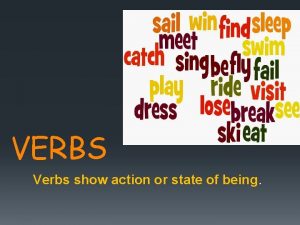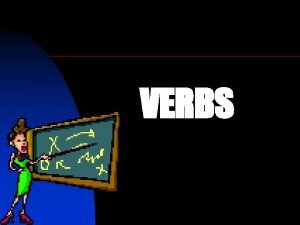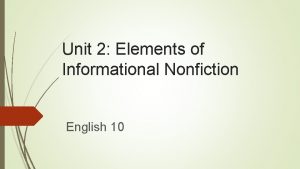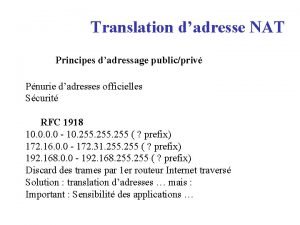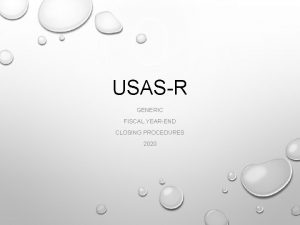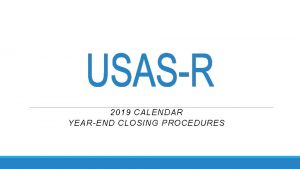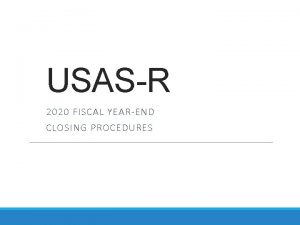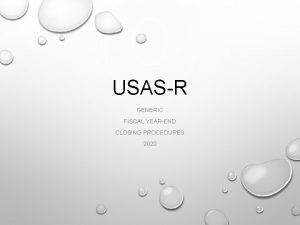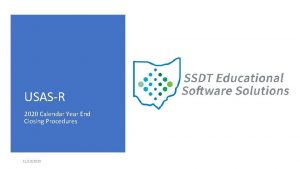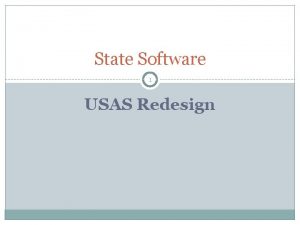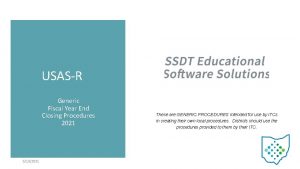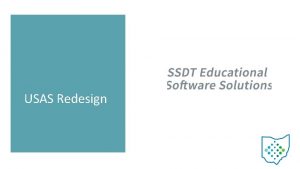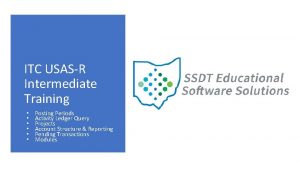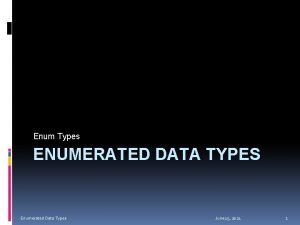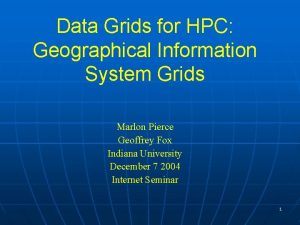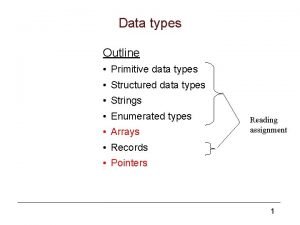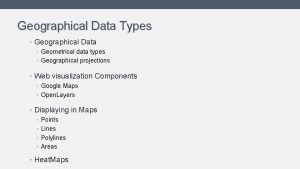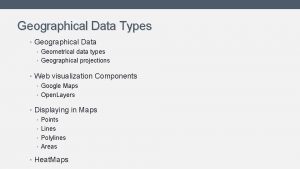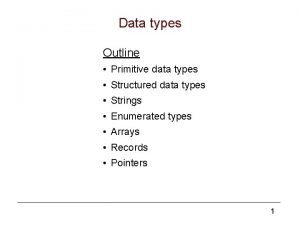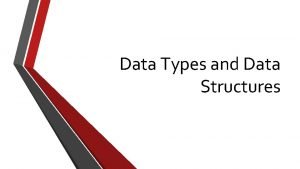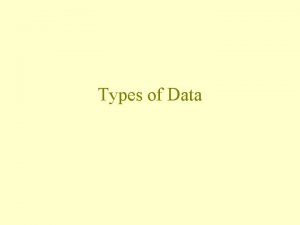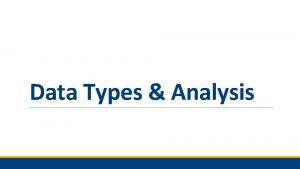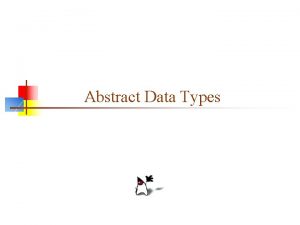USASR Grids Most data types show up in





















































- Slides: 53

USAS-R

Grids Most data types show up in customizable grids User able to select what appears, as well as order Grid is lazy loaded Meaning scroll down through all data and is loaded as you go No maximum records returned and no page numbers No limitation on fields they can query on Filter grid results from filter row Wildcard % Advanced query against any field related to data type Can be saved and recalled Available as filters in reports

Filter Row Filter grid results via a "filter row"which is directly beneath the column headings The default for any text search fields is to select fields starting with the value that you enter. You may also include '%' as a wildcard to find fields containing a value. filter using any of the following. =value or. eq value will select all records equal to the value entered > value or. gt value will select all records greater than the value entered >= value or. ge value will select all records greater than or equal to the value entered (default behavior for numeric fields) < value or. lt value will select all records less than the value entered <= value or. le value will select all records less than or equal to the value entered <> value or. ne value will select all records not equal to the value entered ~ value or. like value will select all records starting with the value entered (only works for text fields; this is the default behavior for text fields if no operator is entered) *= value 1, value 2, value 3 etc. or. one. Of value 1, value 2, value 3 etc. will select records containing one of the values listed value 1. . value 2 or. between value 1, value 2 will select records between the values listed

MORE Allows you to keep add or remove columns (fields) from your grid not limited to just the fields in that program. Example: On PO Grid, I can include the ‘default payment type’ field stored on the vendor record

Advanced Query more elaborate search where you selects the fields (display name) to search on, the operation to search by, and enters what you are searching for (filter value) This may be useful for complex queries where the fields aren’t available under MORE or you don’t want to change your grid set up. Also useful for repetitive searches because you can save your query under a name and recall it whenever needed. Saved queries can also be pulled into a custom report!

USXS-R Home page is the welcome page for the application. You can toggle between all Template reports available or just the Template reports you marked as a Favorite.

Users ○ User accounts from Classic will be imported into USXS-R ○ Users option is under ‘System’ menu. ○ Only users with USAS_USER or USPS_USER permissions will be able to create user accounts and/or change passwords. ○ Assign a Role(s), Filter (USASEC), etc.

Roles ○ Roles defined to represent the basic functions, responsibilities, or tasks of users in the district. ○ Each role is granted one or more "Permissions", each of which allows a specific functionality within the software. ○ For example, default Roles in USAS-R include ○ SSDT encourages districts to create custom roles for their users. Allows much more flexibility and control over “who has access to what” in the system.

Permissions ○ When creating a role, there are many permissions that can be granted. ○ For example, creating a Role for an AR user who creates receipts and refunds. ○ To grant access to all options within receipts, I can click “USAS_RECEIPT”, which gives them access to create, delete, report, update and view receipts.

USAS-R Account Filters ○ Located under the Utilities menu ○ Controls what accounts a user can create, read, update, delete and process transactions against on the system; similar to Classic’s USASEC Account Filters screen ○ ‘C’ create; ‘R’ read; ‘U’ update’ ‘D’ delete’ ‘P’ preencumbrance; ‘E’ encumbrance ○ Each user is assigned an account filter via the System/Users option.

CORE - Accounts Similar to ACTSCN or USASWEB/Accounts in classic Go to Core/Accounts. Select a tab: Cash Appropriation Expenditure Revenue Click the button to create an account. Enter the account code and rest of the details for the account Click the button. NOTES: Appropriation codes will default to the same budget "roll-up" criteria as Classic USAS (two digits of function code with one digit of object code).

CORE - Vendors Similar to VENSCN or USASWEB/Vendors in classic Go to Core/Vendor. Click the button to create a vendor. Enter the vendor details. Click the button. Default Payment Type controls what type of Vendor. Current options: Check and electronic. separate range of numbers for memo vendors no longer needed Multi-vendor flag obsolete No longer need to create a vendor for a multi vendor PO. Req/PO can be created without a vendor number and at invoice time, it will require a vendor be entered. Multiple locations Designate default PO, check, 1099 address Will still need to maintain multiple vendors for different locations

CORE – Delivery Addresses New Feature By default, all deliver-to addresses stored on the reqs and POs in Classic will be imported over; all will be inactive by default Simply check the active box on the delivery addresses you want your district to use. When entering Req/PO, select an existing delivery address from the drop down or enter a new delivery address in the box provided.

Posting Periods ○ Posting Periods is located under the 'Core' menu. ○ Allows flexibility to keep several months open within the same fiscal year. . . in order to post transactions in previous and/or future months. ○ A rule can be enabled to restrict a period from being re-opened once it is closed.

CORE – Other Options USAS-R Classic Comparison Adds/Deducts (Legacy) USASWEB’s Adds/Deducts Option Bank Accounts New Feature OPUs OPUEDT Organization Some of the USACON options Posting Perio Projects ds New Feature PTD fields on the Cash Account

TRANSACTION - Requisitions Similar to REQSCN or USASWEB/Requisitions in classic Go to Transaction/Requisitions. Click the button to create a requisition. Enter the req details. Click the button. Vendor and account code not required when creating a req Split quantity & price are available Users can be restricted on accounts they can process against (Account Filters) Audit trail handled correctly in Redesign Once requisition is converted to a PO, may not be changed or deleted Can not convert one requisition to multiple POs If requisition is updated it keeps track of original ‘posted by’ user Mass Convert option available on grid Requisitions Legacy also available for Requisition Users

TRANSACTION – Purchase Orders Similar to POSCN or USASWEB/Purchase Orders in classic Go to Transaction/Purchase Orders. Click the button to create a PO. Enter the PO details. Click the button. Vendor not required when creating a PO (treated as a multivendor PO) Split quantity & price are available Users can be restricted on accounts they can process against PO may be edited or ‘Amended’

TRANSACTION – AP Invoices (Legacy) AP Invoices is Classic’s USASWEB format so it has all of the same functionality you are currently using in USASWEB’s AP Invoice option It will eventually be replaced with a grid-style format

TRANSACTION – Payables New Feature; basically INVLST in a grid format containing all outstanding invoices awaiting payment Go to Transaction/Payables Select Vendor or Detail tab view Vendor view contains total outstanding invoice amounts summarized by vendor Detail view displays all outstanding invoice details Use either view to select the invoices you want to pay on and click Post Disbursement window Grouping Options: Vendor: similar to Classic’s CKPROC Invoice: separate checks per vendor invoice Click on to post disbursements. Check numbers can be assigned to desired disbursements in disbursements grid

TRANSACTION – Disbursements Provides many check-related Classic programs under one grid Go to Transaction/Disbursements Checkmark Selected Disbursements to: Assign a check number – Generate Print File tab Manually Reconcile – Reconcile tab – similar to RCNCLE/Reconcile Manually Unreconcile – Unreconcile tab – similar to RCNCLE/Reverse Reconcile Void – Void tab – similar to VOIDCK Auto-Reconcile tab: allows you to upload a bank file into a pre-existing bank format; similar to AUTOREC Resequence tab: allows you to resequence check numbering providing an option to void the old checks Similar to CHKSEQ options 1 & 3

TRANSACTION - Receipts Similar to USASWEB/Receipts in classic Go to Transaction/Receipts. Click the button to create a receipt. Enter the receipt details. Click the button. You can edit existing receipt transaction amounts and accounts (no reverse option) You can post receipts and reduction of expenditures. . same as classic

TRANSACTION – Refunds (Legacy) Refunds is currently in Classic’s USASWEB format so it has all of the same functionality you are currently using in USASWEB’s Refund option It will eventually be replaced with a grid-style format

TRANSACTION – Transfers/Advances Similar to ACTMOD’s Fund-to-Fund Transfer options in classic Go to Transaction/Transfers/Advances Click the button to create a transfer or advance. Enter the transaction details. Click the button. NOTE: No longer requires Vendor, PO and Check!

TRANSACTION – Distributions/Error Corrections Similar to ACTMOD’s Distribution/Error Correction option in classic; may use this option for both expenditure and revenue accounts Go to Transaction/Distributions/Error Corrections Click the button to create a distribution/error correction. For transaction using expenditure accounts. Enter a positive amount for reduction of expenditure (incorrect account) Enter a negative amount for a negative reduction of expenditure (correct account) For transaction using revenue accounts Enter a negative amount for incorrect account Enter a positive amount for correct account Click the button. NOTE: No longer requires Vendor, PO and Check; Net amount must be $0 per transaction

TRANSACTION – Activity Ledger New Feature This is a query only grid allowing you to filter existing transactions under the TRANSACTIONS menu Similar to EIEIO options or USASWEB’s query screens all rolled into one grid! Includes the following transactions: Purchase orders Invoices Disbursements Receipts Refunds Transfers Distributions

TRANSACTION – Pending Transactions Similar to classic’s AUTOPOST Contains transactions currently sitting out there from a different system/software waiting to be posted to USAS Example – payroll, BRDDIS or BRDRET file from USPS-R Click on Edit to review transactions and either Post, Reject or Validate Reject sends a message back to USPS-R and removes the pending transaction in USAS-R

USAS-R REPORT – Canned Reports Currently have four canned reports Account Status (Classic’s ACCSTS) Budget Account Activity Report (BUDLED) Financial Detail Report (FINDET) Revenue Account Activity Report (REVLED)

USAS-R REPORT Report Manager SSDT template reports as as well as user-created reports are available under the Report Manager. A template report is a 'starter' report available for you to generate as is or customize to your specifications. The SSDT Template Reports may be generated, viewed (opened) and downloaded only. When opening an SSDT Template report, you will be able to edit the report options, customizing it to your needs and save it under a name of your choosing. Your username will be tied to the newly created report. User-created Template Reports may be generated, viewed (opened), renamed, deleted, downloaded and shared with specific roles.

USAS-R REPORT – Report Manager Available SSDT Template Reports

USXS-R REPORT – Report Manager Generate and Download Option Generates the report as is, allowing you to select the format, orientation, and query parameters before it is generated.

USXS-R REPORT – Report Manager Open Report Definition in Detail Report View Opens the report definition details in order for you to see all of the options chosen for the report. You can then customize it by adding, changing or deleting properties or filters so you get the report you want. Save your changes under a new report name and generate as needed.

USXS-R REPORT – Report Manager Open Report Definition in Detail Report View Select Properties tab

USXS-R REPORT – Report Manager Open Report Definition in Detail Report View Configure Filters tab

USXS-R REPORT – Report Manager Open Report Definition in Detail Report View Generate Report tab Save Report option

USXS-R REPORT – Report Manager Edit Icon Click on report you created in order to rename it, edit the description of the report or edit the tag names associated with the report.

USXS-R REPORT – Report Manager Delete Icon Allows you to delete a report definition you created.

USXS-R REPORT – Report Manager Download Report Definition Allows you to download a report definition you created and then email the report details to others. They can then use to load it into their Report grid.

USXS-R REPORT – Report Manager Share with Roles Allows you to share a saved report definition with users who have a specific role. It will automatically displayed under their Report grid.

USAS-R REPORT Custom Report Creator Favorite If you use a report frequently, checkmark the box in the 'Favorite' column. At the Home page, when you click “Show Favorites”, your selected reports are displayed.

BUDGETING Allows for the creation of budget scenarios and the saving of multiple scenarios for a given fiscal year. Each scenario consists of one or more budgeting (Excel) spreadsheets. A district may choose to use a single spreadsheet containing all accounts, or create a separate sheets for different management areas. An example scenario may be your “High School” and within that scenario, you have several spreadsheets including HS principal, HS Athletic Director, HS Band Director, etc. Once the budgets are completed, the entire scenario can be ‘promoted’ to the “Next Year Proposed” amounts on the budget and/or revenue accounts. The amounts will then be displayed under the ‘Proposed Amounts’ tab under Budgeting

BUDGETING – Scenarios Replacement for APPROP in classic Go to Budgeting/Scenarios. Click to create a Scenario. Enter the Scenario Name and Description Click on at the bottom to create a budgeting spreadsheet for the scenario. You can create several spreadsheets for one scenario Once the spreadsheets have been created, click on the button.

BUDGETING - Scenarios Click on to download the spreadsheet to EXCEL. Enter the proposed amounts and save the completed spreadsheet. Click on to upload the saved spreadsheet into your budgeting scenario. Save changes From the grid, click on the to promote the entire scenario. This will upload proposed amounts from the spreadsheets into Proposed Amounts in the system.

BUDGETING – Proposed Amounts Use the “Proposed Amounts’ option under Scenarios to make any further adjustments to your proposed budget and anticipated revenue amounts by clicking on the ; click on to delete. You can also manually create proposed amounts by clicking on When ready to upload the proposed amounts into initial budget and revenue figures, click on to apply the proposed amounts to the initial budget and/or revenue figures for the selected fiscal year

PERIODIC – Cash Reconciliation Similar to CSHREC option of USAEMSEDT in classic allows the user to create a monthly reconciliation sheet. Click Select the desired posting period Enter the reconciliation information for selected posting period NOTE: Total balances amount (what was entered in) will be automatically compared to the ‘Total Fund Balance’ amount (system amount). Click on to add the reconciliation sheet to the grid.

EXTRACTS – GAAP & Positive Pay GAAP Similar to the GAAPEXP option in USAEXP. allows you to extract fiscal year end activity in order for it to be uploaded in the WEBGAAP system. Positive Pay Similar to AUTOREC’s EXTRACT option Allows you to select the extract fields and starting disbursement date, selecting either CSV or Fixed format.

SYSTEM - Custom Fields A field you define and place in various interfaces can be used when creating, editing, querying and reporting Available in nearly all interfaces Can be used anywhere a normal field is used including queries and reports Enabled or disabled Specify to be included in grid Any Type Text, code, money, number, date/time, web address, email user or Boolean. Code type – user can define their own list of codes with definitions which will produce dropdown boxes in interface Special custom fields – created date/time, last modified date/time Created user and last modified user will automatically be updated by the system

SYSTEM - Custom Field Definitions ○ Example: create a custom field to track W 9 s on Vendor record ○ Before (no W 9 field on vendor record below)

Create a Custom Field ○ Under System menu ○ After (1 st field under 1099 section of Vendor record)

SYSTEM - Configuration details for installed modules Disbursements – how many line items, check stubs, etc 49

SYSTEM - Modules Displays all available modules within the software version the entity is using Required Won’t be able to uninstall Installed + = not installed - = installed 50

SYSTEM - Rules ○ Allows for various types of business rules to be written and easily applied to the system. USx. S-R comes with sets of required business rules, and optional rules that the district may enable or disable as they desire. ○ Customized rules can also be written for each district, either by district personnel with the appropriate access to do so, or with help from their ITC or the SSDT. ○ Customized rules can also be used in conjunction with Custom Fields ○ Bundled Rules means it came with the software ○ Mandatory Rules means it cannot be disabled or modified ○ Bundled Examples: Vendor number can’t be modified (not mandatory); Prevent opening a previously closed period (not mandatory) ○ Mandatory Ex: OPU must have a valid IRN; prevent deleting a transaction when the associated posting period is closed

UTILITIES CHANGE PASSWORD If the user knows their old password they can change their password using the 'change password' link found on the USAS-R Login page or by the 'change password' option under the Utilities Menu FIVE YEAR FORECAST The Five Year Forecast option allows you to extract forecast data for the fiscal year that is current. This is similar to the CSV file automatically generated in Classic's USASFF program. MASS LOAD The Mass Load program allows a district to import cash, expenditure and revenue data into the USAS-R from an outside source (i. e. Excel, Access, Lotus and other third party software's that have the option to export data in a CSV (Comma Separated Values) format. The Mass Load program reads the data, imports and validates it, then writes it to the USAS file structures, thus eliminating manual entry. This might be useful for a district processing mass updates to varying fields Similar to USALOAD’s ACCLOAD option SHOW PROFILE Show profile will give detailed information about the user account currently logged into the USAS-R application. Similar to USASWEB’s ‘show profile’ option

Documentation/Training Materials USAS-R Documentation: https: //wiki. ssdt-ohio. org/display/usasrdoc Includes “differences from Classic’, Navigation; User manual includes an Appendix with several processing guides; Examples include How to create an account Requisition and Purchase Order Step Recorded Demos SSDT You-Tube website: https: //www. youtube. com/user/ssdtohio Fridays with Fiscal: https: //wiki. ssdt-ohio. org/display/ssrd/Redesign+Recorded+Demos Starting up new ‘Fridays’ webinars on November 3 rd Documentation: updating mini-videos in various chapters of the documentation SSDT Newsletters: https: //wiki. ssdt-ohio. org/display/NEWS
 Grid errors
Grid errors Usasr
Usasr Glow discharge system
Glow discharge system Layered architecture for web services and grids
Layered architecture for web services and grids Decimal using grids
Decimal using grids Grids 49152
Grids 49152 Demand response in smart grids
Demand response in smart grids Acted salary grid
Acted salary grid Bootstrap 4 osztály
Bootstrap 4 osztály Differentiation grids
Differentiation grids Types of colloidal dispersion
Types of colloidal dispersion El data show
El data show Pictures of pictograms
Pictures of pictograms Jogo de formão
Jogo de formão The data and scatter diagram show the weight of chickens
The data and scatter diagram show the weight of chickens Complex data types in data mining
Complex data types in data mining Data types in data representation
Data types in data representation Mining complex types of data in data mining
Mining complex types of data in data mining Complex data types in data mining
Complex data types in data mining Most general to most specific classification
Most general to most specific classification Most general to most specific classification
Most general to most specific classification In the name of allah, the most gracious, the most merciful
In the name of allah, the most gracious, the most merciful The most
The most Ponceau pronunciation
Ponceau pronunciation Guddi baji
Guddi baji Organisms taxonomy
Organisms taxonomy Most general to most specific classification
Most general to most specific classification In the name of god most gracious prayer
In the name of god most gracious prayer In the name of allah, the most gracious, the most merciful
In the name of allah, the most gracious, the most merciful In the name of allah the beneficent the merciful
In the name of allah the beneficent the merciful In the name of god most gracious most merciful
In the name of god most gracious most merciful Aqidah
Aqidah In the name of god most gracious prayer
In the name of god most gracious prayer In the name of allah the beneficent the merciful
In the name of allah the beneficent the merciful Gis data input
Gis data input Ways to show respect to others
Ways to show respect to others Show don't tell excitement
Show don't tell excitement Internal monologue format
Internal monologue format Show and tell letter l
Show and tell letter l Answer the questions what is your favourite tv series
Answer the questions what is your favourite tv series Determine if each quadrilateral is a parallelogram
Determine if each quadrilateral is a parallelogram Krowemo
Krowemo Shows an action or state of being
Shows an action or state of being Means using the same pattern of words to show
Means using the same pattern of words to show Which line or lines in this editorial show faulty reasoning
Which line or lines in this editorial show faulty reasoning Enlarged drawings show components larger than their
Enlarged drawings show components larger than their Show ip nat translations
Show ip nat translations Trade show booth staff training
Trade show booth staff training Shifters of srpc
Shifters of srpc Show me your ways meaning
Show me your ways meaning Jenny jones killer
Jenny jones killer The talent show by susan wojciechowski
The talent show by susan wojciechowski Sushi roulette
Sushi roulette In the japanese game show sushi roulette
In the japanese game show sushi roulette

